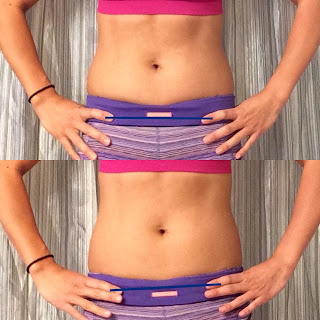A nagging pain develops in the back of your thigh. Was it the added speed work? Maybe the increased milage? Could it be a strained hamstring?
Conventional thought is the hamstring bends the knee. When we want to flex the hamstring our knee bends. However, during function, our muscles work differently. In running, the hamstring slows down knee extension as your knee swings forward. The hamstring muscle elongates to control the knee's motion. This is called eccentric muscle action which puts more stress on the muscle. With increase mileage or speed the hamstring becomes overworked and leads to a strain.
Before we look at hamstring, we have to assess other body regions.
Rule Out These Body Regions...
Low Back

Sacroiliac Joint
Next check to make sure the pelvis is level! The pelvis can become malaligned with a mis-step off a curb, long periods of poor posture or simply imbalance of muscles. The hamstring is attached to the ischial tuberosity on the pelvis. A mis-alignment of the pelvis will have a different pull on the hamstring causing a strain. To perform a quick screen, stand in front of a mirror making sure your feet are aligned forward. Put your hands on your pelvis with the index fingers under the pelvic bone. Look in the mirror to make sure your hands are level. |
| Top picture: shows level position of pelvis. Bottom picture: shows rotated position of pelvis |
***If you have symptoms of low back or sacroiliac dysfunction please go see your physical therapist.
Hamstring vs Gluteals
When we look at the function of the hamstring it is similar function of the gluteals. If the gluteals are weak, the hamstrings are at a biomechanical advantage to take over. In addition to treating the hamstring we have to consider glute strength.
Gluteal strength Test
A quick screen for gluteal strength: Perform 10 on each side. Is there one side that's harder then the other?
Gluteus Medius - Lay on your completely on your side. Leg should be in line with the trunk. Lift leg towards ceiling. ** Make sure to not let the leg drift forward
Gluteus Maximus - Stand in front of a desk and lean forward. Kick your leg back without twisting your hip.

Functional
Single leg squat - Stand on one leg and perform a squat. Keep the knee aligned forward and pelvic level. |
| Left shows good single leg squat form; R shows the knee rolling inward and and the hip dropping |
Basic Strengthening
Clam - Lay on your side with knees bent to about 90 degrees and heel lined with bottom. Keeping the feet together lift knee towards ceiling. The key to this exercise is to ensure the hips are stacked directly on top.
 |
Side leg lift - On your side, hips stacked on top. The bottom leg can be bent for stability. Lift top leg up towards ceiling. Make sure the thigh is in line with the body. The tendency is to allow the leg to drift forward.

Bridges - Lay on your back with your knees bent. Flatten your back by tilting pelvis up. Lift the hips off the ground.

Tri-Plane Strengthening
Tri-planar Lunges with Arm Driver
Using lunges are the best way to strengthen the gluteals. Reaching our arms in different directions can isolate certain muscles. This sequence will help increase gluteal strength. Lunge forward while reaching your hands forward. Next lunge forward while reaching the arms sideways away from the front leg. Lastly turn your arms towards the right leg.
Lunge with reach towards foot
Working the hamstring eccentrically is the best way to simulate it's function while running. Step back with one leg and squat back while keeping the front leg straight.
Treating the Hamstring
Hamstring Stretch
The first couple days of the onset of hamstring pain, the focus is to decrease inflammation. Apply ice for 15 minutes 2-3 times a day to decrease inflammation and take a couple of days off from running. After 3-5 days use a heat pack to help increase blood flow to the area. Gentle stretching of the hamstring can start.Lacrosse Ball Massage
Using a lacrosse ball to massage the hamstrings will help restore mobility of the soft tissue. Providing compression and relaxation to the hamstring will allow improve fluid dynamics of the soft tissue allowing the muscle fibers to glide more efficiently.
A hamstring strain can take up to several months to resolve. However, taking time off from running and performing the proper exercises can accelerate recovery. Be patient!
No comments:
Post a Comment